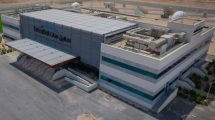 The Kacific1 communications satellite, built by Boeing, has arrived at SpaceX facilities in Cape Canaveral, Florida, where it will be launched atop a Falcon 9 rocket to geostationary orbit.
The Kacific1 communications satellite, built by Boeing, has arrived at SpaceX facilities in Cape Canaveral, Florida, where it will be launched atop a Falcon 9 rocket to geostationary orbit.
Owned by Kacific Broadband Satellites Group (Kacific), this next-generation high-throughput Ka-band satellite will stream broadband to 25 nations in South East Asia and the Pacific Islands via 56 spot beams. Kacific1 is based on Boeing’s reliable 702MP-satellite platform and will provide the most powerful signal level ever achieved in a commercial satellite in the region.
Christian Patouraux, Kacific CEO, founded the company in 2013 with the vision to provide high speed, affordable and accessible internet to extra-urban, rural and remote users. He saw a critical, unmet need in the Asia Pacific region, where high prices and unsuitable technology were prohibiting access. By combining next-generation satellite technology with a lean business model that cuts out the middleman, Patouraux has developed valuable infrastructure for local organisations and people.
Kacific1 will deliver high-speed broadband services to previously unserved or under-served people in nations where populations are widely dispersed, and therefore expensive to connect. Many of these nations are archipelagos or have rugged mountain ranges and large rural territories, making satellite technology the best – and sometimes only – way to connect to the internet and phone networks. The Kacific system will be particularly appealing to the needs of health and education departments in provinces and villages. Furthermore, satellite broadband access provides critical communications channels to a region which is often victim to tropical storms, cyclones, earthquakes and tsunamis.
The Kacific1 payload will share a satellite bus platform with JCSAT-18, ordered by SKY Perfect JSAT Corporation.












Add Comment